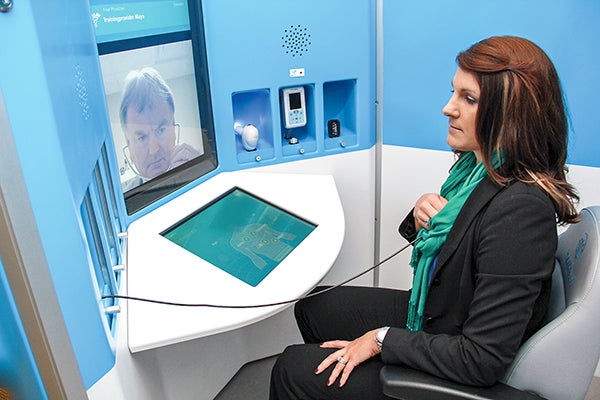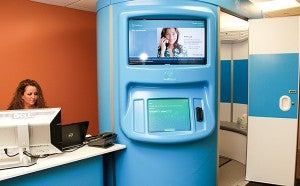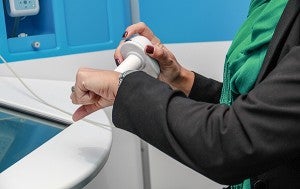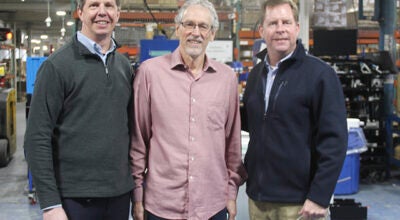Medical possibilities
Published 11:28 am Friday, March 13, 2015

Clinical Operations Manager Melissa Barr demonstrates how an electronic stethoscope works in the HealthSpot kiosk at Mayo Clinic Health System in Austin as Operations Administrator Scott Ramsey listens from several rooms away. The kiosk, part of the Mayo Clinic Health Connection program, will allow patients to be treated for acute care via teleconferencing. – Jason Schoonover/Albert Lea Tribune
Online health kiosk could hold big solutions for Mayo Clinic and Austin Public Schools
An Austin Public Schools and Mayo Clinic Health System partnership could have big implications for both.
Last year, the district went to Mayo with a simple question: “Can we do something to provide easier access — less costly access — for our staff?” according to Superintendent David Krenz.
The district has faced multiple health care issues. Costs have increased after seeing hefty health insurance increases for several years — well before the Affordable Care Act. Availability to see physicians was another issue, with it often taking several months for people to arrange appointments. That often led staff to opt for urgent care or even emergency room visits when certain sicknesses and illnesses came up, and such visits are costly.

Sheryl Ellingson sits at the attendant’s station of the HealthSpot kiosk at Mayo Clinic Health System in Austin. The kiosk will allow patients to be treated for acute care via teleconferencing. The Austin clinic is the pilot site for the Mayo Clinic Health Connection program and will begin by treating Mayo employees and dependents only later this month. – Jason Schoonover/Albert Lea Tribune
The solution, Mayo and the district hope, is Mayo Clinic Health Connection, a kiosk that allows patients to be treated for basic care via teleconference through the HealthSpot platform.
But the two kiosks planned for Austin Public Schools may have a broader impact as this is the first time Mayo is bringing these kiosks directly to an employer.
“All of Mayo Clinic is waiting to see what we learn from these two,” Austin and Albert Lea CEO Dr. Mark Ciota said.
In and out care
In October, Mayo Clinic Health System in Austin and Albert Lea rolled out the first HealthSpot within Mayo at the Austin campus for staff and dependents.
Since then, Ciota said they’ve learned a lot, especially that the kiosks work well for acute care issues — the types of things a patient would go to urgent care for: a cough, allergies, vomiting/diarrhea, sore throat, etc.
“We do find that they are quite efficient as far as being able to easily get an appointment, get what you need and get out,” he said.
For things like severe abdominal pain or potential appendicitis, people would still want to go to the ER.
In the kiosk, a patient teleconferences with a Mayo provider — who can be anywhere — and uses common medical devices like a stethoscope; a thermometer; a dermascope; an otoscope to look inside an ear, nose or throat; and a pulse oximeter to monitor oxygen saturation of the blood and the patient’s pulse.

Clinical Operations Manager Melissa Barr demonstrates how a dermascope works in the HealthSpot kiosk at Mayo Clinic Health System in Austin. The kiosk will allow patients to be treated via teleconferencing. The dermascope allow a provider to look at a patient’s skin, eyes and throats from anywhere with a laptop and the Internet. – Jason Schoonover/Albert Lea Tribune
The district’s kiosks will be staffed by Mayo nurse practitioners, who will be able to help with any anxiety. Mayo employees manning the kiosks was important, according to Ciota, for patients’ privacy and to keep the district out of health care.
“We want to do the health care so they can do the business of teaching students,” Ciota said.
Initially, the kiosks will be open from 7 a.m. to 7 p.m. Monday through Friday.
While Krenz hasn’t been treated through a kiosk, he was impressed by what he saw in demonstrations.
“It really is very interesting,” he said.
The clinic and district anticipate the kiosks will improve the immediacy of care, with shorter wait times to see a medical professional. With the kiosks, district staff can go for a quick kiosk checkup over lunchtime. The aim is to get patients in and out quickly. The average appointment takes about 15 minutes — 9 to 10 with the provider and the rest for registration and prescriptions.
“We don’t want the wait time to be longer than 15 minutes,” Ciota said.
Reduced costs
The kiosks will be installed in Ellis Middle School and the former Home Health Care and Hospice building at 408 Fourth Ave. NW this spring. That puts kiosks on the east and west sides of town near two hubs for the district’s nearly 700 employees — Ellis and I.J. Holton Intermediate School to the east and Austin High School to the west.
Renovation to make space for the kiosk at Ellis cost about $30,000, but Krenz said that should be made up through the money saved by utilizing the kiosks.
The district anticipates the kiosks will help decrease the cost of health care. The kiosk will cost about $50 per use, compared to $100 or more to go in for a traditional appointment.
“There’s really no additional cost to us,” Krenz sad. “We’re looking at potential cost savings.”
The district anticipates saving money by potentially having fewer sick days for appointments thanks to the quick care in kiosks.
“Those are the kind of soft savings that you hope to take care of too,” Krenz said.
The kiosks will be available to district staff and their dependents, but not to students. They’ll also be available to staff not on the district’s insurance. Along with being a money saver for the district and Mayo, Krenz anticipates it will save staff money too.
“It’s a significant cost savings for them, and it provides a certain level of health care they might not already be receiving,” Krenz said.
A culture change
The concept of bringing health care directly to workers is becoming more common. Albert Lea and Red Wing public school districts have clinics within the schools, and Quality Pork Processors in Austin opened a clinic in 2013.
The health care industry is changing, and Ciota said they’ll be subject to different payment methods and have to adapt to treat groups of patients as efficiently as possible, even if that means less revenue for the clinic — which the kiosks could.
But the technology-heavy kiosks present a culture change for school staff and for the way people receive health care. The changes won’t happen or be embraced overnight. Krenz admitted change takes time.
“It’s hard to really know what to anticipate,” Krenz said of district staff. “They don’t know what they are.”
Medical center staff proved a good test group for the kiosks as most are tech savvy, and Ciota expects the teachers to adapt quickly too. The district is already trying to ensure that happens.
The district is working to educate staff on the kiosks to help encourage use to make sure employees are comfortable using them.
Clinic employees and dependents proved a small sample size compared to the nearly 700-plus employees for the district; however, Ciota said they’re ready for the increased volume.
“We knew and anticipated that,” he said.
Future expansion?
So far, both sides are pleased with the partnership.
“Austin public schools have just been fantastic to work with,” he said.
Mayo’s goal is to provide high quality while reducing the cost. The endeavor is a true partnership, and Ciota said they want to hear from the schools on how to improve.
“We want input from them,” he said.
Initially, the district expects the partnership to last about two to three years, at which time the idea will be reassessed. If it goes well, the district could one day add more kiosks at other schools and potentially open them up to students and their families.
Mayo is also watching closely. If successful, the kiosks could be used further at Mayo and in other locations.




